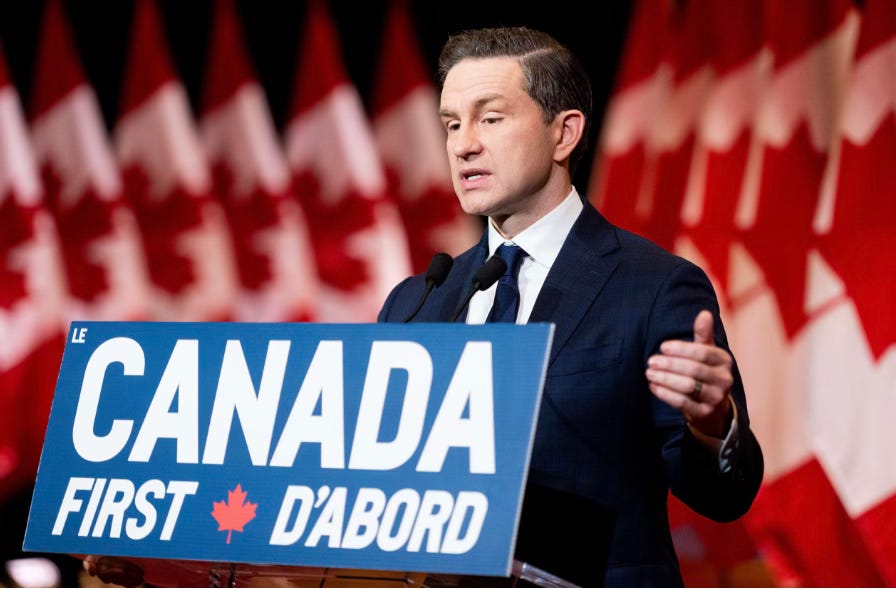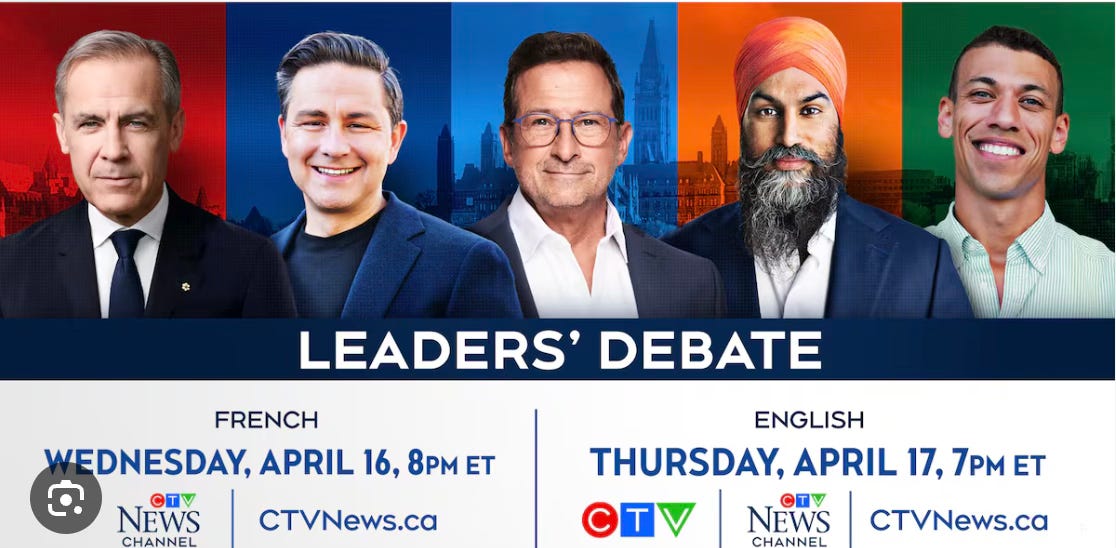Poilievre's Unsustainable Obstinacy/ L’insostenibile ostinazione di Poilievre
The Conservative leader seems trapped in a stale campaign groove/Il leader conservatore sembra intrappolato in un messaggio elettorale ormai logoro (testo italiano dopo l'inglese)
With only two weeks to go, Poilievre clings to an outdated message, while the Liberals capitalize on growing fears of Trump’s America. Are the upcoming TV debates the Conservatives’ last chance to shift momentum?
Leader of Canada's Conservative Party, Pierre Poilievre, speaks during a 'Spike the Hike-Axe the Tax' rally in Edmonton, on March 27, 2024, in Edmonton, Alberta, Canada. (Artur Widak/NurPhoto via Getty Images)
We had already noted that a segment of Canada’s conservative intelligentsia was beginning to show signs of unease with Pierre Poilievre’s electoral strategy ahead of the upcoming federal election on April 28. The strategy—crafted in a different political era, before Trump’s return to the White House and his remarks about Canada as the ideal 51st state—was built around the country’s tangible problems: weak economic growth, stagnant productivity, soaring housing prices, and overstretched social services. These are issues for which it is easy to place blame on the party that has been in power for the past decade, that is, the Liberals led by Justin Trudeau.
A Now-Failing Slogan
Enter Trump, and Poilievre’s message to voters has remained essentially unchanged over the past two months, centered around the mantra “Axe the tax. Build the homes. Fix the budget. Stop the crime.” The slogan intended to frame the campaign—“Canada First”—now even risks evoking, at least rhetorically, that very Trumpian universe many Canadian voters see as the country’s real problem, even more so than inflation (see Table 1).
Table 1: Top issues that Canadians want the federal government to address post-election (CityNews-Leger poll).
Carney and the Anti-Trump Strategy
It is no coincidence that on the opposing side there is an effort to capitalize on the current idiosyncrasy of Canadians towards anything American, in an attempt to make voters forget that Mark Carney's party is still the same as Trudeau's. The Liberal’s electoral strategy is built around a key message: “President Trump wants to break us so that America can own us. That will never happen.” Consequently, each programmatic statement is framed within the mission Carney offers to voters – “Fight, protect, build” – aimed at making Canada as autonomous and independent as possible from an ally with whom it has been in substantial symbiosis for the past 80 years.
Poilievre, to be fair, envisions the same endgame — a stronger, more self-reliant Canada — but he insists on framing the country’s current predicament as the direct result of a decade under Liberal rule rather than as a consequence of the reckless words and actions coming from the White House. Yet voters seem more receptive to a narrative that casts Trump, unequivocally, as the villain. As Globe and Mail columnist Shannon Proudfoot notes, “Canadians are cancelling U.S. travel plans and becoming experts in country of origin labels, and yet Mr. Poilievre continually paints Mr. Carney and the “lost Liberal decade” he mentioned about 162 times this week as nastier villains than Mr. Trump.”
Tensions Within the Conservative Camp
The numbers indicate that Poilievre’s message is failing to gain meaningful traction: with just two weeks remaining before the vote, the Liberals are polling at around 44%, while the Conservatives trail at 37%. While it’s true that polls may not always mirror the final outcome, a further indication that Poilievre’s campaign may be faltering is the recent appearance of former Conservative Prime Minister Stephen Harper—who governed the country for a decade (2006–2015)—at a rally in support of the current Conservative leader. As veteran Canadian political commentator Chantal Hébert notes: “Former prime ministers tend to show up at your side when you're desperately in need of wind in your sails.” Hence, the mounting unease within the opposition party, most recently reflected in remarks by Kory Teneycke—a prominent and seasoned figure in conservative circles, who formerly served as head of communications for Ontario’s Progressive Conservative Party, the party that recently re-elected Premier Doug Ford. According to Teneycke, Poilievre’s campaign must urgently shift direction and focus its efforts on confronting Trump’s tariffs.
Showdown Debates Ahead
But with just two weeks until election day, time is running out. The last opportunity for Poilievre to turn the situation around will likely be the two televised debates scheduled for April 16 and 17 (the first in French, the second in English), where the leaders of the five parties running (the New Democratic Party, Bloc Quebecois, and Green Party, in addition to the Liberals and Conservatives) will gather for a collective face-off.
Carney may face some challenging moments, especially in the first debate, as his French is not flawless. Moreover, he has never participated in a political debate, let alone one where four opponents will relentlessly attack him, given that he is the front-runner. But Poilievre cannot simply rely on a mistake from his opponent—one that might never come. On that occasion, he will have to explicitly state, especially since the others will provoke him on the matter, whether or not he believes America, or at least this America, represents an existential threat to Canada. Doing so could alienate that not insignificant minority of Trump supporters within his electorate. Failing to do so will cost him those 'centrist' votes without which, in Canada as elsewhere, elections cannot be won.
L'insostenibile ostinazione di Poilievre
A due settimane dal voto, Poilievre si aggrappa a un messaggio ormai logoro, mentre i liberali sfruttano i timori suscitati dall'America di Trump. I prossimi dibattiti televisivi potrebbero essere l'ultima vera chance per i conservatori
Avevamo già segnalato come una parte dell’intellighenzia conservatrice canadese stesse iniziando a mostrare segni d’insofferenza nei confronti della strategia elettorale del leader del Conservative party Pierre Poilievre in vista delle elezioni federali del prossimo 28 aprile. Una strategia concepita in un’altra era – prima del ritorno di Trump alla Casa Bianca e dei suoi commenti sul Canada come perfetto 51imo stato dell’Unione – e strutturata attorno ai problemi concreti del paese (scarsa crescita, produttività stagnante, prezzi delle case alle stelle, servizi sociali in affanno) per i quali è facile attribuire la responsabilità al partito al potere da un decennio, vale a dire i Liberal guidati da Justin Trudeau.
Uno slogan che non tira più
Poi è arrivato Trump, ma il messaggio di Poilievre agli elettori è rimasto pervicacemente immutato negli ultimi due mesi: “Axe the tax. Build the homes. Fix the budget. Stop the crime" (Taglia le tasse, costruisci case, metti a posto il bilancio, ferma il crimine”). E lo slogan che doveva incorniciare la campagna – “Canada First” – ora rischia di evocare, quantomeno sul piano retorico, proprio quell’universo trumpiano che molti elettori canadesi percepiscono come il vero problema del Paese, persino più dell’inflazione (vedi tabella).
Le principali questioni che i canadesi vogliono che il governo federale affronti dopo le elezioni. (Sondaggio CityNews-Léger)
Carney e la strategia anti-Trump
Eppure, il messaggio di Poilievre agli elettori è rimasto pervicacemente immutato negli ultimi due mesi: “Axe the tax. Build the homes. Fix the budget. Stop the crime." (Taglia le tasse, costruisci case, metti a posto il bilancio, ferma il crimine”). E lo slogan che doveva incorniciare la campagna – “Canada First” – ora rischia di evocare, quantomeno sul piano retorico, proprio quell’universo Trumpiano che molti elettori canadesi percepiscono come il vero problema del Paese, persino più dell’inflazione (vedi tabella).
Non è un caso che nel campo avverso si cerchi di capitalizzare sull’attuale idiosincrasia dei canadesi verso tutto ciò che è statunitense nel tentativo di far dimenticare che quello di Mark Carney è pur sempre lo stesso partito di Trudeau. La strategia elettorale è incardinata su un messaggio chiave: “President Trump wants to break us so that America can own us. That will never happen” (Il presidente Trump vuole spezzarci per poterci dominare. Noi non glielo permetteremo). Conseguentemente, ogni dichiarazione programmatica (chiamate qui pledges) viene inscritta nella mission offerta da Carney agli elettori – “Fight, protect, build” (combattere, proteggere, costruire) – al fine di rendere il Canada autonomo e il più possibile indipendente rispetto a un alleato con cui è stato in sostanziale simbiosi negli ultimi 80 anni.
Pierre Poilievre, leader dei Conservatori, e lo slogan della sua campagna che riecheggia quello di Trump durante una conferenza stampa il 2 marzo 2025 a Ottawa (Spencer Colby/The Canadian Press).
Tensioni nel campo conservatore
Anche Poilievre, va detto, indica la stessa meta – un Canada che diventi più forte per essere indipendente – ma la chiave d’entrata è sempre quella di ricondurre la situazione in cui si trova attualmente il Canada ai dieci anni di governo Liberal piuttosto che alle improvvide esternazioni e decisioni dell’inquilino della Casa Bianca. L’elettorato però sembra più ricettivo a un messaggio che individua senza caveat in Trump il “nemico numero uno”. Come nota l’opinionista del Globe and Mail Shannon Proudfoot, “Mentre i canadesi disdicono viaggi negli Stati Uniti e leggono attentamente le etichette dei prodotti per non comprare ‘made in the Usa’, Poilievre continua imperterrito a dipingere Carney e quel 'decennio perduto dei liberali' (citato 162 volte solo questa settimana) come nemici peggiori persino di Trump.
I numeri confermano che il messaggio di Poilievre non sembra passare: a due settimane dal voto i Liberal sono dati attorno al 44%, i Conservative al 37%. Sono solo sondaggi, si dirà, e possono non rispecchiare la realtà. Ma che le cose non stiano andando bene per Poilievre lo conferma anche il fatto che l’ultimo Primo ministro conservatore del paese, restato al potere dieci anni (2006-2015), Steven Harper, si è sentito in dovere di presentarsi in un comizio assieme al leader dei Conservative. Come ricorda Chantal Hebert, la decana dei commentatori politici canadesi: “Gli ex primi ministri tendono a presentarsi al tuo fianco quando hai disperato bisogno di vento nelle vele”. Da qui il nervosismo nel campo del partito di opposizione, il cui ultimo esempio è l’esternazione di un rispettato esponente della galassia conservatrice, Kory Teneycke, uno che di comunicazione elettorale se ne intende avendo guidato quella del Progressive Party dell’Ontario, il partito che recentemente ha rieletto il premier Doug Ford. La campagna di Poilievre, sostiene Teneycke, deve assolutamente cambiare rotta e concentrarsi sulla lotta contro i dazi di Trump.
Dibattiti in TV: La prova del fuoco
Ma il tempo stringe, mancano due settimane al voto, e probabilmente l’ultima occasione per Poilievre di capovolgere la situazione sono i due dibattiti televisivi in programma il 16 e 17 aprile (il primo in francese, il secondo in inglese) dove i leader dei cinque partiti in lizza (New Democratic Party, Bloc Quebecois e Green Party, oltre ai Liberal e ai Conservative) saranno riuniti in un faccia a faccia collettivo.
Carney potrebbe andare in difficoltà, soprattutto nel primo, non essendo il suo un francese impeccabile. Inoltre non ha mai affrontato un dibattito politico, figuriamoci uno in cui quattro avversari lo attaccheranno a piè sospinto, essendo lui il favorito. Ma Poilievre non può limitarsi a sperare in un passo falso dell’avversario, che potrebbe anche non esserci. In quell’occasione dovrà, anche perché gli altri lo provocheranno al riguardo, dire esplicitamente se ritiene o meno che l’America, o perlomeno questa America, rappresenti una minaccia esistenziale per il Canada. Farlo potrebbe alienargli quella minoranza non insignificante di trumpiani presente nel suo elettorato. Non farlo gli farà mancare quei voti ‘centristi’ senza i quali, in Canada come altrove, le elezioni non si vincono.










